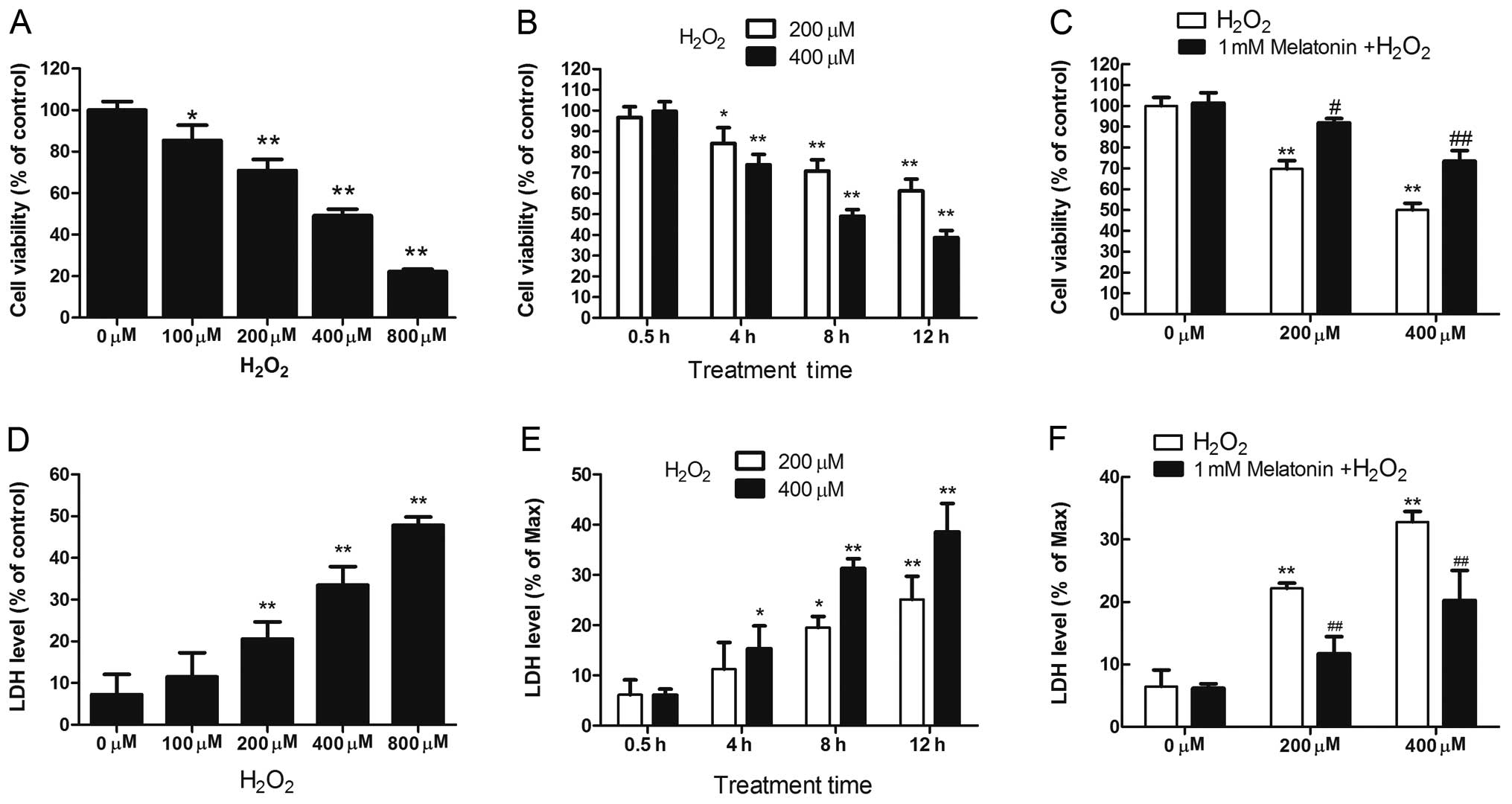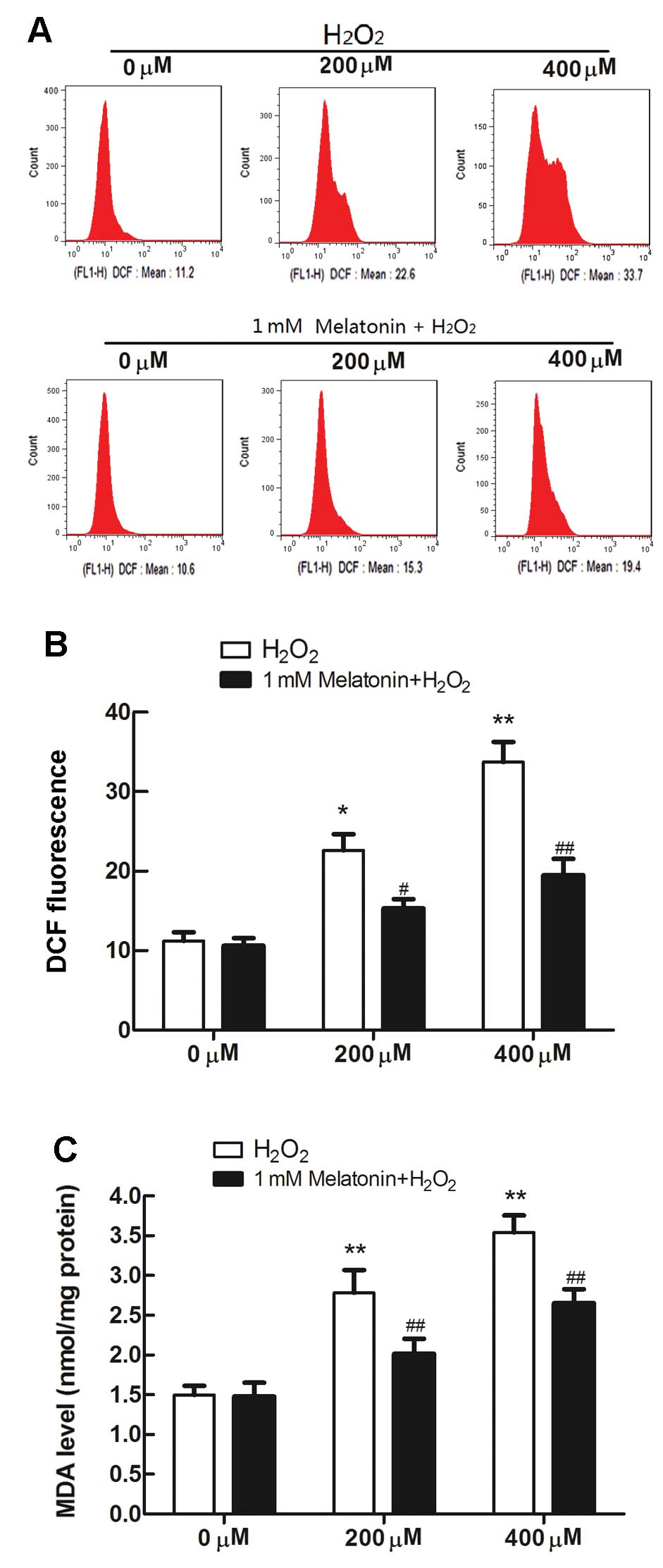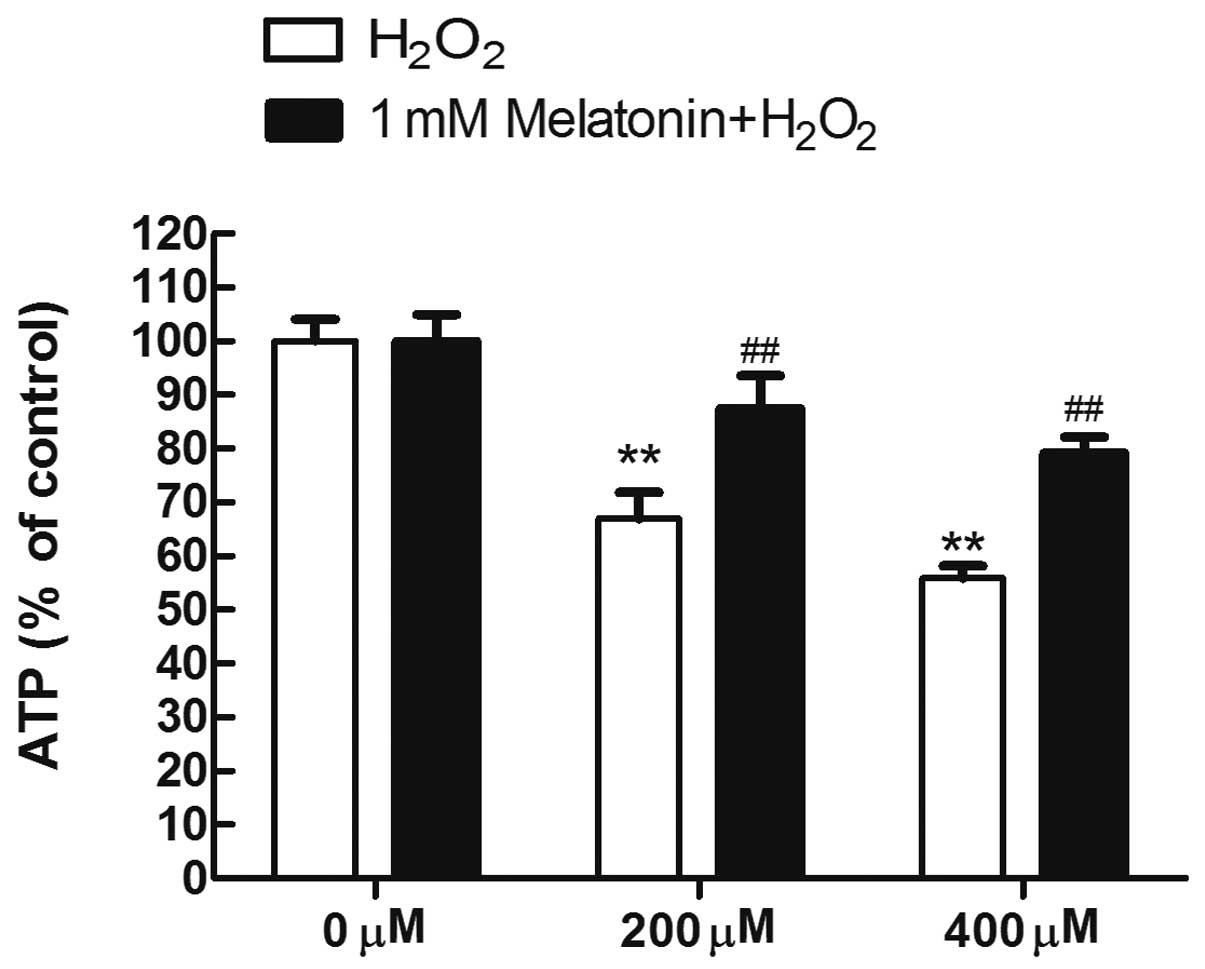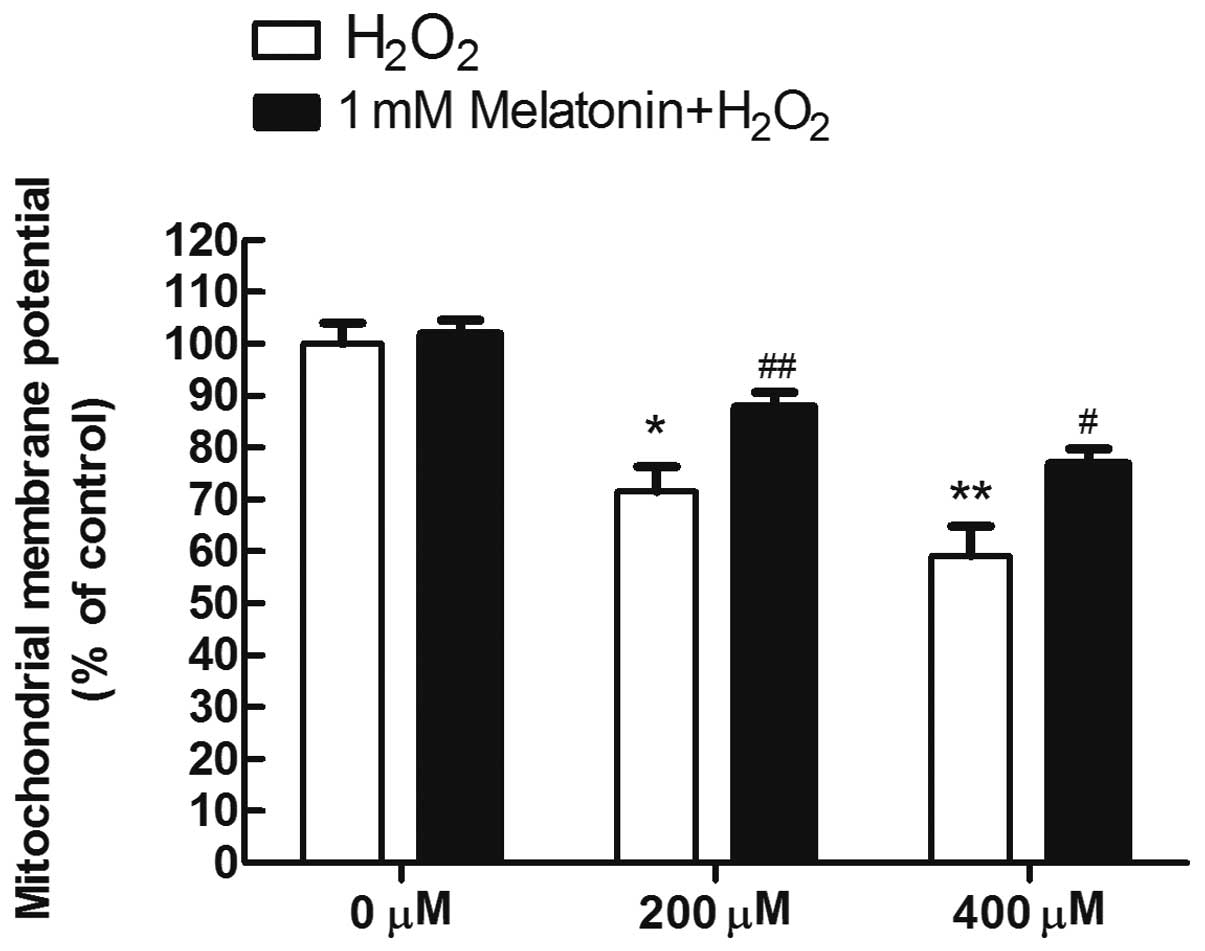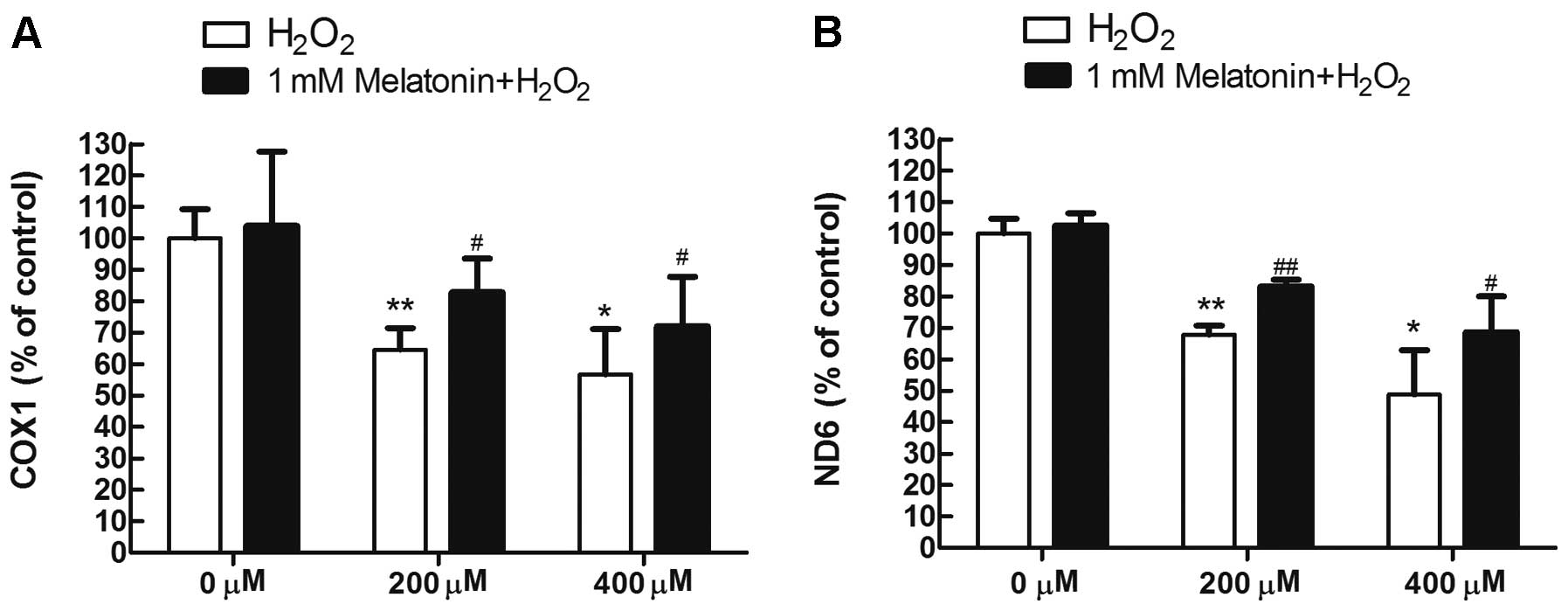|
1
|
Sandhu SK and Hampson G: The pathogenesis,
diagnosis, investigation and management of osteoporosis. J Clin
Pathol. 64:1042–1050. 2011. View Article : Google Scholar : PubMed/NCBI
|
|
2
|
Choi EM: Magnolol protects osteoblastic
MC3T3-E1 cells against antimycin A-induced cytotoxicity through
activation of mitochondrial function. Inflammation. 35:1204–1212.
2012. View Article : Google Scholar : PubMed/NCBI
|
|
3
|
Xu ZS, Wang XY, Xiao DM, et al: Hydrogen
sulfide protects MC3T3-E1 osteoblastic cells against
H2O2-induced oxidative damage-implications
for the treatment of osteoporosis. Free Radic Biol Med.
50:1314–1323. 2011. View Article : Google Scholar : PubMed/NCBI
|
|
4
|
Park BG, Yoo CI, Kim HT, Kwon CH and Kim
YK: Role of mitogen-activated protein kinases in hydrogen
peroxide-induced cell death in osteoblastic cells. Toxicology.
215:115–125. 2005. View Article : Google Scholar : PubMed/NCBI
|
|
5
|
Lee HC and Wei YH: Oxidative stress,
mitochondrial DNA mutation, and apoptosis in aging. Exp Biol Med
(Maywood). 232:592–606. 2007.PubMed/NCBI
|
|
6
|
Raha S and Robinson BH: Mitochondria,
oxygen free radicals, disease and ageing. Trends Biochem Sci.
25:502–508. 2000. View Article : Google Scholar : PubMed/NCBI
|
|
7
|
Choi EM: Deoxyactein isolated from
Cimicifuga racemosa protects osteoblastic MC3T3-E1 cells
against antimycin A-induced cytotoxicity. J Appl Toxicol.
33:488–494. 2013.
|
|
8
|
Slominski A, Fischer TW, Zmijewski MA, et
al: On the role of melatonin in skin physiology and pathology.
Endocrine. 27:137–148. 2005. View Article : Google Scholar : PubMed/NCBI
|
|
9
|
Bubenik GA: Gastrointestinal melatonin:
localization, function, and clinical relevance. Dig Dis Sci.
47:2336–2348. 2002. View Article : Google Scholar : PubMed/NCBI
|
|
10
|
Jimenez-Jorge S, Jimenez-Caliani AJ,
Guerrero JM, et al: Melatonin synthesis and melatonin-membrane
receptor (MT1) expression during rat thymus development: role of
the pineal gland. J Pineal Res. 39:77–83. 2005. View Article : Google Scholar : PubMed/NCBI
|
|
11
|
Rosenstein RE, Pandi-Perumal SR,
Srinivasan V, Spence DW, Brown GM and Cardinali DP: Melatonin as a
therapeutic tool in ophthalmology: implications for glaucoma and
uveitis. J Pineal Res. 49:1–13. 2010.PubMed/NCBI
|
|
12
|
Conti A, Conconi S, Hertens E,
Skwarlo-Sonta K, Markowska M and Maestroni JM: Evidence for
melatonin synthesis in mouse and human bone marrow cells. J Pineal
Res. 28:193–202. 2000. View Article : Google Scholar : PubMed/NCBI
|
|
13
|
Rajaratnam SM, Middleton B, Stone BM,
Arendt J and Dijk DJ: Melatonin advances the circadian timing of
EEG sleep and directly facilitates sleep without altering its
duration in extended sleep opportunities in humans. J Physiol.
561:339–351. 2004. View Article : Google Scholar
|
|
14
|
Arendt J and Skene DJ: Melatonin as a
chronobiotic. Sleep Med Rev. 9:25–39. 2005. View Article : Google Scholar
|
|
15
|
Armstrong SM: Melatonin and circadian
control in mammals. Experientia. 45:932–938. 1989. View Article : Google Scholar : PubMed/NCBI
|
|
16
|
Deacon S and Arendt J: Melatonin-induced
temperature suppression and its acute phase-shifting effects
correlate in a dose-dependent manner in humans. Brain Res.
688:77–85. 1995. View Article : Google Scholar
|
|
17
|
Srinivasan V, Spence WD, Pandi-Perumal SR,
Zakharia R, Bhatnagar KP and Brzezinski A: Melatonin and human
reproduction: shedding light on the darkness hormone. Gynecol
Endocrinol. 25:779–785. 2009. View Article : Google Scholar : PubMed/NCBI
|
|
18
|
Guerrero JM and Reiter RJ:
Melatonin-immune system relationships. Curr Top Med Chem.
2:167–179. 2002. View Article : Google Scholar : PubMed/NCBI
|
|
19
|
Hardeland R, Poeggeler B, Niebergall R and
Zelosko V: Oxidation of melatonin by carbonate radicals and
chemiluminescence emitted during pyrrole ring cleavage. J Pineal
Res. 34:17–25. 2003. View Article : Google Scholar : PubMed/NCBI
|
|
20
|
Coto-Montes A and Hardeland R: New vistas
on oxidative damage and aging. Open Biol J. 3:39–52. 2010.
View Article : Google Scholar
|
|
21
|
León J, Acuña-Castroviejo D, Escames G,
Tan DX and Reiter RJ: Melatonin mitigates mitochondrial
malfunction. J Pineal Res. 38:1–9. 2005.PubMed/NCBI
|
|
22
|
Klongpanichapak S, Phansuwan-Pujito P,
Ebadi M and Govitrapong P: Melatonin protects SK-N-SH neuroblastoma
cells from amphetamine-induced neurotoxicity. J Pineal Res.
43:65–73. 2007. View Article : Google Scholar : PubMed/NCBI
|
|
23
|
Duan Q, Wang Z, Lu T, Chen J and Wang X:
Comparison of 6-hydroxylmelatonin or melatonin in protecting
neurons against ischemia/reperfusion-mediated injury. J Pineal Res.
41:351–357. 2006. View Article : Google Scholar : PubMed/NCBI
|
|
24
|
Herrera F, Martin V, Garcia-Santos G,
Rodriguez-Blanco J, Antolin I and Rodriguez C: Melatonin prevents
glutamate-induced oxytosis in the HT22 mouse hippocampal cell line
through an antioxidant effect specifically targeting mitochondria.
J Neurochem. 100:736–746. 2007. View Article : Google Scholar
|
|
25
|
Chen LJ, Gao YQ, Li XJ, Shen DH and Sun
FY: Melatonin protects against MPTP/MPP+-induced
mitochondrial DNA oxidative damage in vivo and in vitro. J Pineal
Res. 39:34–42. 2005. View Article : Google Scholar : PubMed/NCBI
|
|
26
|
Jou MJ, Peng TI, Yu PZ, et al: Melatonin
protects against common deletion of mitochondrial DNA-augmented
mitochondrial oxidative stress and apoptosis. J Pineal Res.
43:389–403. 2007. View Article : Google Scholar : PubMed/NCBI
|
|
27
|
Tan DX, Manchester LC, Terron MP, Flores
LJ and Reiter RJ: One molecule, many derivatives: a never-ending
interaction of melatonin with reactive oxygen and nitrogen species?
J Pineal Res. 42:28–42. 2007. View Article : Google Scholar : PubMed/NCBI
|
|
28
|
Reiter RJ, Tan DX, Jou MJ, Korkmaz A,
Manchester LC and Paredes SD: Biogenic amines in the reduction of
oxidative stress: melatonin and its metabolites. Neuro Endocrinol
Lett. 29:391–398. 2008.PubMed/NCBI
|
|
29
|
Choi EM, Kim GH and Lee YS: Diazoxide
protects against hydrogen peroxide-induced toxicity in the
osteoblastic MC3T3-E1 cells. Eur J Pharmacol. 624:45–50. 2009.
View Article : Google Scholar : PubMed/NCBI
|
|
30
|
López A, García JA, Escames G, et al:
Melatonin protects the mitochondria from oxidative damage reducing
oxygen consumption, membrane potential, and superoxide anion
production. J Pineal Res. 46:188–198. 2009.PubMed/NCBI
|
|
31
|
Xu S, Zhong M, Zhang L, et al:
Overexpression of Tfam protects mitochondria against
beta-amyloid-induced oxidative damage in SH-SY5Y cells. FEBS J.
276:3800–3809. 2009. View Article : Google Scholar : PubMed/NCBI
|
|
32
|
Acuña Castroviejo D, Escames G, Carazo A,
León J, Khaldy H and Reiter RJ: Melatonin, mitochondrial
homeostasis and mitochondrial-related diseases. Curr Top Med Chem.
2:133–151. 2002.PubMed/NCBI
|
|
33
|
Xu S, Zhou Z, Zhang L, et al: Exposure to
1800 MHz radiofrequency radiation induces oxidative damage to
mitochondrial DNA in primary cultured neurons. Brain Res.
1311:189–196. 2010. View Article : Google Scholar : PubMed/NCBI
|
|
34
|
Escames G, López A, García JA, et al: The
role of mitochondria in brain aging and the effects of melatonin.
Curr Neuropharmacol. 8:182–193. 2010. View Article : Google Scholar : PubMed/NCBI
|
|
35
|
Vairetti M, Ferrigno A, Bertone R, et al:
Exogenous melatonin enhances bile flow and ATP levels after cold
storage and reperfusion in rat liver: implications for liver
transplantation. J Pineal Res. 38:223–230. 2005. View Article : Google Scholar : PubMed/NCBI
|



